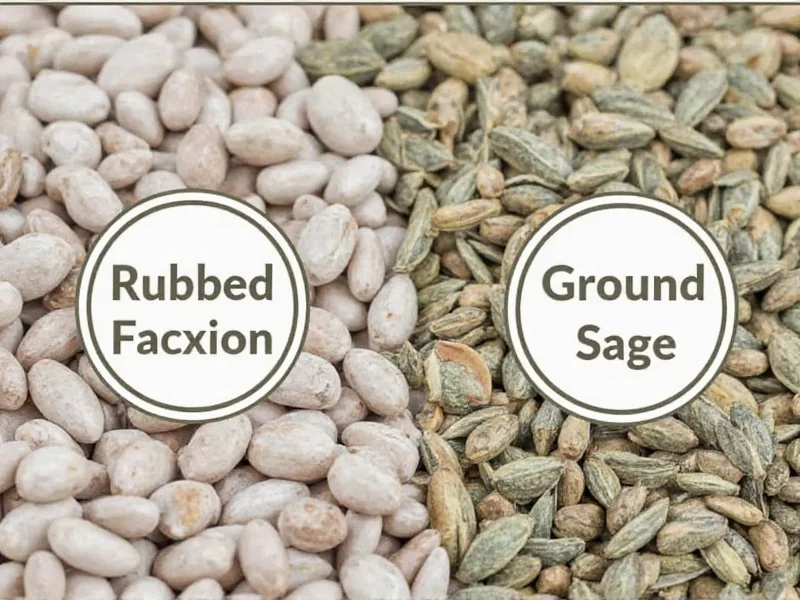Understanding the distinction between rubbed and ground sage is essential for achieving perfect flavor balance in your cooking. These two preparations of the same herb serve different culinary purposes despite originating from the same plant (Salvia officinalis). The processing method dramatically affects their texture, potency, and ideal applications in recipes.
What Is Rubbed Sage?
Rubbed sage, sometimes labeled as “crumbled sage,” undergoes a gentle processing method where dried sage leaves are rubbed between screens or hands. This careful technique separates the essential oil-rich leaf particles from the tougher stems and veins.
The resulting product maintains some leaf structure while achieving a light, airy consistency. Rubbed sage typically appears as soft, fluffy green fragments that retain visible pieces of the original leaf. This preparation method preserves more of the herb’s volatile oils compared to grinding, resulting in a more delicate, nuanced flavor profile.
Chefs often prefer rubbed sage for dishes where you want subtle herbal notes without overwhelming other ingredients. It disperses evenly in recipes without creating concentrated “hot spots” of intense flavor. This makes it particularly suitable for delicate sauces, light pasta dishes, and recipes with shorter cooking times.
What Is Ground Sage?
Ground sage undergoes a more intensive processing method where dried sage leaves are milled into a fine, uniform powder. This complete pulverization releases more of the herb’s essential oils and compounds, creating a more potent product.
The resulting powder has a consistent texture with no visible leaf fragments. Ground sage appears as a deep green to olive-colored fine powder that can sometimes clump if exposed to moisture. Because the grinding process breaks down all plant material, including stems and veins, ground sage delivers a more intense, sometimes slightly bitter flavor compared to rubbed sage.
Ground sage works best in recipes with longer cooking times or robust flavors that can stand up to its potency. It’s commonly used in sausage making, hearty stews, and spice blends where its strong flavor can mellow and integrate with other ingredients. The fine texture also makes it ideal for dry rubs that need to adhere closely to meat surfaces.
| Characteristic | Rubbed Sage | Ground Sage |
|---|---|---|
| Texture | Light, fluffy with visible leaf fragments | Fine, uniform powder |
| Flavor Intensity | Milder, more nuanced | Stronger, more concentrated |
| Color | Brighter green | Deeper olive green |
| Best For | Delicate sauces, short-cooking dishes | Long-cooking recipes, spice blends |
| Substitution Ratio | 1 teaspoon = 1/2 teaspoon ground | 1/2 teaspoon = 1 teaspoon rubbed |
| Shelf Life | 6-9 months | 4-6 months |
Practical Substitution Guidance
When substituting between rubbed and ground sage, remember that ground sage is approximately twice as potent due to its concentrated form. The general conversion ratio is:
- 1 teaspoon rubbed sage = 1/2 teaspoon ground sage
- 1 tablespoon rubbed sage = 1 1/2 teaspoons ground sage
When making substitutions in recipes, add ground sage gradually and taste as you go, as it’s easier to add more than correct an over-seasoned dish. For the most accurate results, especially in baking or precise recipes, consider weighing your herbs rather than measuring by volume.
Storage Recommendations
Both forms of dried sage benefit from proper storage to maintain freshness and potency. Store in airtight containers away from light, heat, and moisture. Dark glass jars or opaque containers work best.
Rubbed sage typically maintains its quality for 6-9 months when properly stored, while ground sage loses potency more quickly (4-6 months) due to its increased surface area exposed to air. To test if your sage is still fresh, rub a small amount between your fingers—fresh sage should release a strong, pleasant aroma.
Common Culinary Mistakes to Avoid
Cooks often make these errors when using different sage preparations:
- Using equal amounts of rubbed and ground sage without adjusting for potency differences
- Adding ground sage too early in cooking, resulting in bitter flavors
- Storing sage in transparent containers that degrade the essential oils
- Using old, stale sage that has lost its aromatic compounds
- Confusing rubbed sage with rubbed sage seasoning blends that contain additional ingredients
For optimal results, add rubbed sage during the last 10-15 minutes of cooking to preserve its delicate flavor, while ground sage benefits from being added earlier to allow its stronger flavor to mellow and integrate with other ingredients.
When to Choose Each Form
Select rubbed sage when you want:
- Subtle herbal notes in creamy sauces or light pasta dishes
- Even distribution without concentrated flavor pockets
- A brighter green color in finished dishes
- To season delicate proteins like chicken or fish
Choose ground sage when you need:
- Stronger flavor for hearty dishes like sausages or stews
- A consistent texture for dry rubs
- Efficient incorporation into doughs or batters
- Longer shelf stability in spice blends











 浙公网安备
33010002000092号
浙公网安备
33010002000092号 浙B2-20120091-4
浙B2-20120091-4